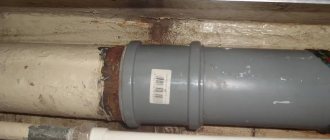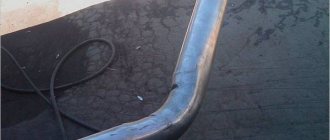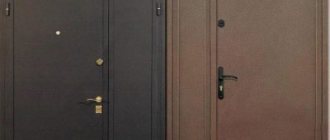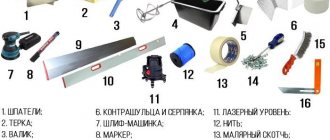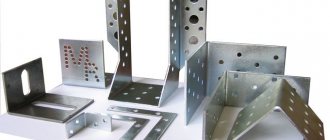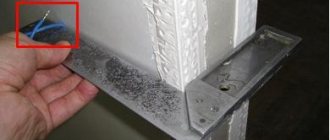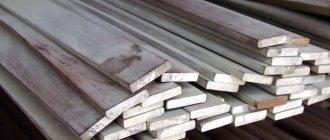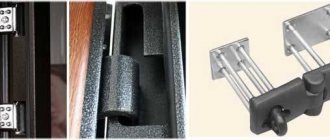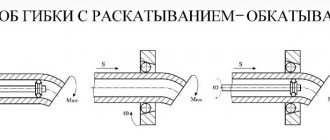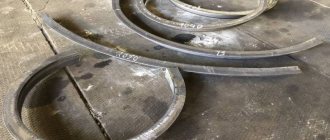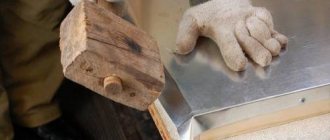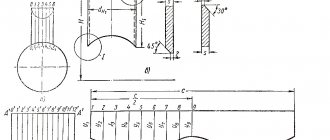When working with metal, you often have to deal with the manufacture of products from steel strip - staples, clamps, brackets. But not everyone knows how to bend a metal strip without losing strength and achieving the required configuration accuracy. However, this is a fairly simple operation that does not require particularly sophisticated tools. Only in the case of bending a strip on an edge, a rather complex device is needed, which is not easy to make yourself.
Bending the strip at an angle (60, 90, 1200...) towards the plane is done on a regular bench vice if you need to make a single product or several pieces. In the case of small-scale production, you will need a machine for bending metal strips. If necessary, you can do it yourself.
Bending a metal strip into a ring and onto an edge
Not everyone knows how to bend a metal strip without losing strength and achieving configuration accuracy. To avoid reinventing the wheel, read our tips!
When working with metal, you often have to deal with the manufacture of products from steel strip - staples, clamps, brackets. But not everyone knows how to bend a metal strip without losing strength and achieving the required configuration accuracy. However, this is a fairly simple operation that does not require particularly sophisticated tools. Only in the case of bending a strip on an edge, a rather complex device is needed, which is not easy to make yourself.
Bending of the strip at an angle (60, 90, 120 0 ...) towards the plane is done on a regular bench vice if you need to make a single product or several pieces. In the case of small-scale production, you will need a machine for bending metal strips. If necessary, you can do it yourself.
How to bend a profile pipe
Greenhouses of various sizes and purposes, gazebos and other structures on the site are built using profile pipes. Such metal structures have one distinctive feature: bending the pipe with or without a pipe bender leads to deformation of the workpiece (flattening or cracks may occur). It doesn’t hurt to know how to bend a profile pipe at home correctly so as not to damage the material.
The solution to this problem is quite simple: it is also filled with sand or water, which is subsequently frozen. Following these simple steps reduces the risk of pipe damage and allows you to achieve the desired result. The same method can be used when deciding how to bend an aluminum or brass pipe without a pipe bender (about
Bending strips using a vice
First, let's consider the option of bending on a bench vice at an angle of 90 0. To do this, you need a square block of steel. We clamp the strip together with the block so that the block is located on the side of the fixed jaw of the vice and protrudes 1-2 cm above the upper edge.
After such a “sandwich” is firmly clamped, take an ordinary hammer and bend the strip towards the block with light blows. If it is required that the bend surface is not damaged by impacts, then you need to use a copper or brass gasket, which we will hit with a hammer, and from it the force will be transferred to the strip.
In this way, you can bend the strip at any angle; it is only important to select a support block with the desired cutting angle. Without such solid support, achieving the desired angle will be very difficult.
Similar operations are performed in the manufacture of clamps, only in this case we use a thick-walled pipe or rod of the required diameter as a matrix. As in the case of a rectangular bend, blows with a hammer are applied towards the stationary jaw of the vice. This kind of strip bending is a slow process and requires care.
DIY bending machine.
People, I see, come here in particular for search queries regarding bending machines. Some people even skim and read a lot. They would have scribbled at least a line, at least a response.
Before starting the various metal work planned for this season, I decided to make myself a homemade bending machine (a machine for bending profiles, strips, reinforcement, straightening corners), because the successful outcome of this enterprise will determine the work on the following projects. Those. without a bending machine it’s one conversation, with a working bending machine it’s another.
A bending machine should be moderately versatile. Those. The simplest machine for bending clamps is not suitable for me, because it is single-tasking. I have plans not only to bend strips at any angle, but also to bend arcs and, if possible, bend rectangular pipes.
The role model I chose is this:
But I don’t have 44,000 rubles for this, or even 15,000, for which I can buy something that, theoretically, will also suit me.
But I saw a jack in “Metro” for 450 rubles
with a force of 2 tons. This is where the puzzle began to take shape in my head.
Having understood the principle of operation of the above press, I isolated from there only the components for bending corners, leaving the rolling of profiles behind for a while (I’ll leave this upgrade for later).
Having gotten to know the jack better, I realized that it only works in a vertical position, i.e. my plans to make a horizontal machine are not coming true (in a horizontal machine the oil seems to flow in the wrong direction). This imposes great restrictions on the nature of the work performed on the machine. Let's say I won't be able to bend long parts. Or you will have to place the machine on some kind of high bed so that the bent wings of the parts have somewhere to fall.
We draw a diagram of the machine in a program available to me.
The base of the frame is a 100 mm channel. For rollers - two hinges for gates - another 200 rubles
to the budget. One of the main initial tasks: manufacturing the punch and the system for attaching it to the jack. Because I plan to have several punches for different types of work performed, then I need to come up with a system for quickly and easily changing punches (more on this below). The first punch is for bending angles of 90 degrees or more. Working part: 32 and 25 mm corners inserted into each other. The body is also made from a 25 mm corner. The rest is metal to fill the internal cavity. There is a 40*20 pipe and three pieces of fittings.
The frame is based on a 100 mm channel (found among the metal at the dacha). For stop rollers - two gate hinges - another 200 RUR
to the budget.
One of the main initial tasks: manufacturing the punch and the system for attaching it to the jack. Because I plan to have several punches for different types of work performed, then I need to come up with a system for quickly and easily changing punches (more on this below).
Bending strips into a ring
The strip is placed between the rollers and pressed using a screw mechanism. When the drive roller rotates, the strip begins to move between it and the support rollers and bend towards the drive. After a complete pass of the strip, an almost perfect ring is obtained. If you make the handle telescopic so that the arm can be made longer, then you can bend strips of almost any thickness onto the ring without much physical effort.
This homemade strip bending machine is practically no different from the factory one. With the right choice of metal for the rollers and clamping device, small-scale production, for example for the manufacture of decorative fences, gates or frames of canopies and awnings, is possible even in a home garage, not to mention a metalworkshop.
Bend and install drywall end strip
The length of the end strip should be slightly longer than the arc of the arch. This is necessary so that after installing the end strip, you can trim its ends and make a smooth transition from the drywall to the end walls of the opening. To bend a pre-cut strip of drywall onto the end of the arch, we will use the dry method of cross cuts.
On the tensile (inner) side of the drywall, you need to make transverse cuts every 5-7 cm to 2/3 of the thickness of the drywall core. Once the cuts are made, the strip of drywall can be easily attached to the arc of the arch frame. You need to attach from the middle of the arch moving towards the edges. Drywall-metal screws are screwed into each section of the strip between the slots. The protruding drywall is cut off with a knife or hacksaw. The door arch is made of plasterboard; painting work remains.
Bending strips on edge
If bending is often done on strips of different widths, then you need to make several blocks with slots corresponding to the gauge that is being processed. But a homemade tool, for all its attractiveness and cheapness, is still inferior to an industrial one, the functionality of which is much higher.
Hand tools are produced in the form of universal devices, in which only the attachments and levers are changed, or in the form of entire sets, where each mechanism performs only one, maximum two functions. An example of such a kit is “Cold forging” of industrial production.
Moreover, their cost is not too high even for a home craftsman. Finding the necessary parts for a homemade machine, assembling, fitting and tuning will not cost much less, even with proper metalworking qualifications. If you do not buy the cheapest tools, then bending machines will work for decades.
Strip metal bending
A series of articles devoted to metal processing continues on our website. We talked about how sheets and rolls from the delivery state are unraveled into strips (strips) in the article “Metal slitting lines.”
Metal bending is done using specialized equipment or manually. We described how this happens with imported equipment using the example of products from the Italian machine tool concern WARCOM. We talked about the use of domestic sheet bending machines for these purposes in an article about the Lipetsk sheet bending plant.
Today we will talk about manual bending of strip metal.
- Manual bending of strip metal
- Right angle bending
- Bending at an acute angle
- Manufacturing of staples and clamps
- Bending connection
- Edge bending
Manual bending of strip metal
Manual processing of metal strips is a labor-intensive operation, in most cases requiring special training of the worker and the appropriate tools. This operation is performed by a mechanic at a specially equipped workplace:
- a mechanic's workbench equipped with an appropriate vice;
- set of locksmith tools.
Let's look at a few simple operations with strip metal.
Right angle bending
We will bend the strip steel in a bench vice. Place the workpiece (clamp it) in a vice.
Bending in a vice.
We do this in such a way that the side with the bending point faces the stationary jaw of the vice (away from the worker). In this case, the mark should be approximately 0.5 mm higher than the jaw of the vice. Hammer blows should be applied in the direction of the stationary jaw of the vice. To avoid injury (if the workpiece springs back), the mechanic, when performing this operation, should not be positioned in the path of the hammer.
Bending at an acute angle
In this case, a mandrel having the required angle is used. It is installed in a vice along with the workpiece, as shown in the figure (with the high side facing the workpiece). The workpiece is deformed by hammer blows until it touches the bevel of the mandrel.
Manufacturing of staples and clamps
To make a bracket, you should use a frame block, the thickness of which will be equal to the opening of the bracket. Next, you should fasten the strip with the mandrel in a vice, as indicated in the figure, and bend first one side, and then the other.
Manufacturing of staples and clamps.
To make a clamp, fix the frame in a vice and bend a strip on it (see figure). Then, bend the ends of the clamp, release the equipment from the vice and use a hammer to give the part its final shape on the workbench table.
Hammer blows should not be applied to the clamp itself, so as not to leave scratches, nicks and dents on it. They should be carried out through a copper plate of small thickness, since it will well redistribute the impact force.
Bending connection
Strip bending is widely used for bending joints of parts. The connection can be completely bendable, as shown in the figure. Here, the fastening force is created by bending one part (often all connected parts are deformed).
In a number of cases, strip bending plays a supporting role. It can, for example, strengthen a threaded connection.
Examples of bending connections.
The figure shows examples of strip bending and strengthening of a nut-bolt threaded connection: a cotter pin and a lock washer.
Edge bending
The operation is performed on the roller machine shown in the figure.
Bending steel strip “on edge”.
There are two features of this machine to consider:
- the upper guide of the base bar must have a groove that exactly matches the size of the deformed metal strip;
- The working roller and the top of the strip must be lubricated with grease.
These are the basic simple techniques for manually bending strip metal.
At the addresses indicated here you can select and purchase a metal bending machine.
Types of bending machines
There are 2D and 3D bending machines. The former are used for the manufacture of simple flat products: hooks, hangers, wire frames, etc. 3D wire machines are universal bending machines suitable for the production of almost any wire product: trays, brackets, baskets, etc. Three-dimensional bending is made possible thanks to the presence of a rotary console. Spring winding machines should be included in a separate group. Their use allows you to make springs of various diameters and with different numbers of turns in a matter of seconds. Based on the type of raw materials used, there are:
- sheet metal bending machines;
- machines for bending reinforcement;
- bending machines for profile pipes;
- tape bending machines;
- wire bending machines.
Our website presents machines for working with metal strip, pipe, wire and fittings, as well as a specialized machine for making letters from aluminum strip for signs.
Edge bending process
We place the anvil on its side on a massive and durable base. We cut out a pair of approximately square plates from different sized corners. Using a grinder and pliers, we round two corners of each of them.
Approximately in the middle of one side of the large plates, we mark and make a horizontal cut with a length equal to the height of the rail base. From its end downwards at an angle coinciding with the inclination of the rail neck, we make a second cut.
We place the steel strip that is to be bent across the anvil.
To the strip held on the edge, we apply smaller plates on both sides, which with their flat edges are in contact with the side of the rail head.
Holding the plates in this position, with the workpiece located between them, we attach them to the anvil by welding.
After making sure that the workpiece slides freely between the stops, we weld along their perimeter.
In the same way, using the strip as a template, we weld large plates to the base and neck of the rail thanks to the cutouts. We make sure that the strip moves freely, without jamming, between two pairs of limiters in the longitudinal direction in both directions.
We place the workpiece with one end between the smaller stops welded to the base of the anvil, and begin to strike the upper edge of the strip measuredly and with equal force, gradually pushing it from the head to the base of the anvil.
If the strip bends to the side, we remove it by hitting it with a hammer in the opposite direction.
When I reach the middle of the strip, we bring its other end into the limiters and repeat the previous operation.
Gradually, the free ends of the workpiece will begin to converge, and depending on their relative position, by adjusting the location and force of the blows, we ensure that its ends rest against each other.
If there is lateral curvature, the product is straightened on a flat and hard surface.
Bend a ring from a metal strip.
There was a need to make several rings from a metal strip 8mm thick and 55mm wide. The outer diameter of the ring is 400mm, and the inner diameter is 300mm. After bending and welding, it is finally processed on a lathe. Maybe someone has encountered a similar problem and can suggest bending technology. Perhaps there are devices for bending similar parts. I would be grateful for advice and suggestions.
Stupid question, but won't thin tape work? In general, I would contact a decent forge with this question.
eug28 wrote: There was a need to make several rings from a metal strip 8mm thick and 55mm wide. The outer diameter of the ring is 400mm, and the inner diameter is 300mm.
Something is unclear, how can this be, the outer diameter is 400 mm, the inner diameter is 300 mm, with a wall thickness of 8 mm? (400-300): 2 = 50mm, the wall thickness should be, not 8mm, if we are talking about a ring. Will scraps of pipes of the required diameter be suitable?
Suever wrote: Something is unclear, how can this be,
The strip should bend along its width, not its thickness, if I understand correctly. For such parameters it is necessary to use something like an industrial pipe bender with a powerful electric drive with appropriate mandrels.
It’s easier to cut it out of an 8 mm sheet using gas and trim it on a machine. If this is not possible, then really go to the blacksmith.
Madman wrote: For such parameters it is necessary to use something like an industrial pipe bender with a powerful electric drive with appropriate mandrels. __________________
In this case, you need to bend it on the “edge”, 8mm on the edge is something not ice, then it’s easier to draw it on an 8mm sheet, and even cut it out with a jigsaw. I understand, but it’s necessary.
In general, try to do this with a cardboard model, manually bend it on its edge, it either folds correctly or breaks, IMHO the same will happen with metal, so it’s better to cut it from a sheet.
Yann: - It’s difficult to bend. Usually cut from sheet. You go to the local boiler house or water utility, take a bottle and go to the mechanics. They are aware of these issues. I have several 400 * 10 mm nickels lying around at home, these are plugs from equipment. But how can I give them to you?
2eug28 Never bend this strip into a flat, smooth ring using any equipment. It is necessary to cut from a single sheet with gas, EMF, a jigsaw, a grinder or directly on a lathe
Vidis wrote: You need to cut from a single sheet with gas,
I think that after gas it will only end up as scrap metal.
You won't be able to bend it. If there is no solid sheet for the ring, you can weld it from a strip - in sectors (chords) with cutting and then on the machine. Something like this, if the width is 55:
Suever wrote: I think after gas he will behave like this
I assure you, it won’t lead.
You just need to make a ring X mm wide Y mm, then cut out a piece (sector) to form a sort of letter C and bend it on an anvil along the diameter until the edges meet... accordingly, do everything on a cardboard model... plus allowances for manual processing, and forward.. They usually make a cone that way.. but in general, to the pipe plant.. just order what you need..
Suever wrote: I think that after gas it will only end up as scrap metal.
Yann: - It doesn’t matter, this is usually done everywhere, and this work itself is well known to welders. You can do it yourself, find a cutter and the necessary hardware. Well, you can bend the rod, weld it and take it to the forge, where it will be heated and flattened. I see the way out as follows: - “Either to the forge, or to the welder.”
If you use a forge to forge, the thickness may turn out to be uneven. Easier to cut from a sheet. Yes, even with a jigsaw. (I won’t say anything about how many files it takes)
Medtech wrote: You just need to make a ring X mm wide Y mm, then cut out a piece (sector) to form a sort of letter C and bend it on an anvil along the diameter until the edges meet .. accordingly, do everything on a cardboard model .. plus manual allowances processing, and forward.. They usually do a cone like that..
I didn’t understand anything: why “cut a piece” out of a finished ring and then bend it? The author has a 55x8 strip, but he needs to make flanges (it looks like the 299th pipe).
Yann wrote: find a cutter and the necessary iron.
You forgot about a normal carver.
Yann wrote: It doesn’t matter, that’s how they usually do it everywhere
Once upon a time they cut an 8 mm sheet, for gates, bicycles, with a continuous cut. They began to cut with dotted lines, the result was a little better.
Suever wrote: Something is not clear, how can this be, the outer diameter is 400 mm, the inner diameter is 300 mm, with a wall thickness of 8 mm?
Where did the wall come from? I asked to share the technology. And there is one. If you have nothing to offer, it is better to remain silent. IMHO.
Malevich wrote: you can weld from a strip - in sectors (chords) with cutting and then on the machine.
It’s theoretically possible, of course, to weld from segments, but practically 12 (in your drawing) segments in one plane, but no matter how you cut it, you can’t weld, IMHO.
Metal fittings
Metal reinforcing bars are bent only when cold. It is unacceptable to file or heat the bend area. By making your work easier, you greatly weaken the rod; during subsequent use, the rod is destroyed under load.
An acceptable bending radius is 10–15 bar diameters. Correct bending up to an angle of 90° (right angle) does not damage the quality characteristics; then a gradual decrease in strength begins. Strict adherence to the process technology is the key to the absence of damage to the rod in the form of folds or kinks. If you are not sure how much you can bend reinforcement of a particular radius, please clarify this issue with our managers when choosing reinforcement in our catalog.
How does bending happen?
The basic principle of operation of most devices for bending steel reinforcement is as follows. The reinforcing bar comes into contact at the point of future bending with a stationary central roller. On the other side of the rod there are two stops - bending and fixing.
After the operation begins, the bending stop begins to move, puts pressure on the rod and forces it to rotate around the central roller, as in a balance swing. At this time, the locking stop prevents the other end of the rod from moving to the side under the influence of the lever mechanism, as a result the rod bends. The bending radius corresponds to the radius of the central roller.
The above diagram is the most common, but it does not exhaust the variety of bending methods.
Bending devices
The choice of bending equipment is determined by the diameter and profile of the reinforcement, as well as the volume of work.
Electrically driven machine . Indispensable for the construction of large objects or bending of reinforcement with a diameter of over 20 mm. Capable of bending several rods at once. The permissible range of rod diameters depends on the power of the equipment.
Hand mechanical tool . A more mobile portable version, attached to a workbench. Powered by muscle power, no electricity required. Designed for a small amount of reinforcement. The working diameter is usually up to 20 mm, although tools are also available for larger rods. The price of the equipment is low, this is a reasonable solution to the problem when building a private house.
Homemade devices . There are two types: 1) copying factory hand tools, 2) other improvised methods. The latter includes bending rods with two pieces of pipe, with a sledgehammer after clamping in a vice, or using driven stop pins. Homemade devices, like hand tools, are only suitable for small diameters. The main disadvantages are the low quality of bending, the possibility of damage to the reinforcement, and the risk of injury. Our company’s employees warn that it’s not worth the risk; it’s better to buy or rent real equipment, not homemade equipment.
Bending technology - basic information
Metal bending is performed without welding seams, which avoids corrosion in the future and produces a product of increased strength. Deformation does not require significant effort and is usually performed in a cold state.
The exception is hard materials such as duralumin or carbon steels. Sheet metal bending technology is developed according to the assigned tasks in such options as:
- radius,
- multi-angle,
- single-angle,
- U-shaped.
A special case is flexion with stretching. This technology is used in the manufacture of parts with large bending radii and small diameters. When making parts with your own hands, the process is combined with operations such as cutting or punching.
Soft types of metals and alloys, such as brass, copper, and aluminum, are well suited for home processing. The production of products by bending is carried out on rolling or rolling machines, or manually.
The last procedure is quite labor-intensive. Bending is done using pliers and a rubber hammer. If the sheet is thin, use a mallet.
How to bend at right angles
To bend a bracket from a metal sheet, you will need a set of tools and accessories, consisting of:
- vice,
- hammer,
- power saws,
- bar,
- frames
The length of the strip is made according to the scheme, with the calculation that there should be a margin of 0.5 mm for each bend, plus another millimeter for folds on both sides. The workpiece is placed in a vice with squares. Clamping it along the fold line, process it with a hammer.
After this, the future bracket is unfolded in a vice, clamped with a frame and a block, and the other side is formed. The workpiece is pulled out, the required length of the sides is measured, making bends along the bottom.
Use a triangle to check the correctness of the angle, correcting inaccuracies with a hammer. When performing both operations, the workpiece is pressed with a block and a frame. The finished staple is filed to the desired size.
How to make a sheet bending machine yourself
To give the metal the desired configuration, tinsmiths use a sheet bending machine. But what should a master do if he doesn’t have special equipment at hand?
In fact, the question of how to bend sheet metal at home is easily resolved. It is enough to use your own ingenuity and basic equipment to make a simple machine.
To make a bender for a metal profile, you will need:
- I-beam 80 mm,
- fasteners (bolts),
- loops,
- corner 80 mm,
- clamps,
- a pair of handles.
You will also need a welding machine and a stable table on which the finished machine is mounted.
The basis of the device is an I-beam, to which a corner is screwed with two bolts, holding the workpiece during the bending process. Three door hinges are attached under it by welding. Their second part is welded directly to the corner.
In order for the machine to easily turn while bending sheet metal, handles are attached to it on both sides. The finished machine is secured to the table with clamps. Before laying the workpiece, the corner is unscrewed or lifted. The sheet is pressed, aligned along the edge and folded, turning the machine by the handles. The homemade device is only suitable for processing workpieces of small thickness.
Bending a metal sheet with a hammer
In order to bend a sheet up to 1.2 mm thick at a right angle, use the simplest tools - pliers (clamps) and a rubber hammer.
The processing is carried out on a flat wooden block. The fold line is drawn using a pencil and ruler. Then the sheet is clamped with pliers so that their ends fall exactly on the marking line.
The edge is gradually bent upward, moving along the fold. Once the angle approaches 90 degrees, the sheet is placed on the block and finally leveled using a hammer.
Narrow parts, such as tin edges, are made in this way.
Tip: Use a rubber or wooden hammer to prevent dents from forming on the metal. If bending is performed with a conventional tool, you need to take a textolite plate as a gasket.
It is convenient to bend sheets up to 2 mm thick on a desktop. The metal is positioned so that the marking line falls on the edge. A steel corner is placed under the material being processed.
The sheet is clamped in a vice using two wooden blocks. Bending is done using a hammer, tapping the metal from one end to the other. At the same time, the edge of the sheet is directed downward so that it ultimately lies completely on the corner fixed along the edge of the table. This method can be used to make products of any width, including boxes or barbecues.
Making pipes without using a machine
Home craftsmen have invented a lot of ways to bend a metal sheet into a pipe without using a machine.
We propose to consider the simplest option using a blank of suitable size. It is made from an old pipe of suitable diameter.
A sheet of metal is laid out on the floor and a piece of the required length is cut from it. To determine the required size, the required pipe diameter is multiplied by 3.14 and added 30 mm for the seam.
A pair of tubes are welded to the blank on both sides, perpendicular to one another. The crowbar should be freely inserted into their holes.
Master's recommendation: by bending a metal sheet using a blank, it is convenient to make pipes no more than a meter in length.
To use the device, the effort of three people is required. The blank is placed on the edge of the sheet. One person stands on top, two others screw the metal onto the blank, turning the crowbar 90 degrees.
The entire length of the sheet is rolled in this way, the remaining edge is hammered. The seam is secured by welding.
It must be taken into account that the bend radius of sheet metal depends on its thickness and manufacturing method. Hot rolled steel is more suitable for pipes; profile products are made from cold rolled steel.
How to bend a strip of metal into a circle - Metalworker's Guide
Most people ask themselves: how to bend a metal sheet evenly? And it is not surprising, because during construction work there may be a need to perform a similar procedure.
Small diameter pipes are bent using a vice. Quite often during construction processes there is a need to bend pipes of quite large diameter. For such work, special machines are needed, which are used to bend sheets of metal and pipes. The bent ingredient does not change its original shape.
How to bend a metal sheet evenly? Stages:
| General methodology, principles and specifics of elastic metal sheets. |
| What metal can be bent? The most suitable materials for processing and giving the desired shape are brass, copper and aluminum. |
| Bending tools. At the beginning of work, it is necessary to prepare a diagram of the future product and calculate the required angle. After this, you need to acquire materials and tools. |
| Handmade production of a machine for bending sheet metal. Materials and work plan. |
Tip: when bending parts, its thickness, elasticity are taken into account and the radius of curvature is determined.
Elastic metal technique
Bending sheet metal involves performing specific actions that lead to the material receiving the required shape. The process of bending metal is performed without the help of welding or other connections that reduce the durability and reliability of the material.
When folded, the layers on the outside of the product are stretched, and the layers on the inside are compressed. The technique is to bend one part in relation to the other to the required angle.
In a timely manner, the elastic sheet of metal undergoes deformation. Its value depends on the thickness of the product, ductility, bending angle and bending speed.
The process itself is performed on equipment, so no damage occurs.
If the part is bent incorrectly, then unequal defects may occur on its surface, due to which the metal receives unequal damage along the bending line, which usually leads to its failure.
The bending stress must be greater than its stiffness limit. As a result of elasticity, plastic deformation can occur. Moreover, after the bending operation is carried out, the finished structure will retain the shape that was given to it.
The advantages of the process of flattening and elasticizing a metal sheet:
- Greater productivity of the process.
- As a result of bending, you can obtain a workpiece without a seam.
- The finished structure has high corrosion resistance.
- Corrosion does not appear at the bend site.
- The structure is considered solid.
- Great strength.
Flaws:
If you want to learn more about repairs, check out this site.
Common site here.
- The necessary equipment is expensive.
- Manual elastication is too labor intensive.
Unlike structures made by bending metal, welded structures have a weld seam that is subject to rust and corrosion.
Products are folded manually or using specialized devices. Manual bending is a difficult and difficult procedure to work with, which is done using pliers and a hammer. If it is necessary to evenly bend a metal sheet of small thickness, use a mallet.
Bending of sheet metal is carried out using rollers, roller machines or a press. To give the material a cylindrical shape, hydraulic, manual or electrically conductive rollers are used. Pipes are made in a similar way.
Elastic sheet metal is used for home construction purposes for the manufacture of drainage systems, metal frames, profiles, pipes and other structures. By bending the material with your own hands, you can make pipes of various diameters. Using machines, products with a protective zinc coating are bent. To do this, you need to make a machine, preferably using a template.
When bending any product, it is necessary to determine its parameters. The length of the structure is calculated taking into account the radius. For workpieces that are bent at right angles, without forming roundings, the allowance should be 0.6 mm of the entire thickness of the sheet.
You can bend the following metals on your own:
The bending radius depends on the quality properties of the metal and the elasticity option.
How to bend a metal sheet evenly with your own hands?
To produce staples using the elastic method, the following materials and tools are used:
- vice;
- Metal sheet;
- frame;
- hammer;
- electric saw for metal;
- bar.
In advance, according to the scheme, the length of the workpiece strip is calculated and the calculation of bending of the metal sheet is performed. For each bend, a reserve of 0.5 mm of thickness is made and 1 mm for bending the ends to the side. According to a plan drawn up in advance, the workpiece is cut out and the bend location is marked. In order to bend the material, a vice with squares is used.
First, at the bending level, you need to clamp the workpiece in a vice. Then the first bend is made using a hammer. The workpiece is rearranged in a vice and clamped by the frame together with the block, after which the second bend is made.
The workpiece is removed and the length of the staple legs is marked. It, together with the block, is bent by the frame and at the same time its two legs are bent. The triangle is used to clarify the bend. If it is done incorrectly, the bend should be corrected using a frame block and a hammer. When the bending procedure is completed, the structure is filed to the required specifications.
How to bend a metal sheet evenly: making a machine with your own hands
In order to create a device that allows you to bend a sheet of metal at home, you need to prepare the following tools and materials:
- corner 80 mm;
- bolts;
- metal I-beam 80 mm;
- loops;
- inverter device;
- clamps;
- handles;
- table.
All work begins with preparing the base of a homemade machine from a profile - an 80 mm I-beam. Then an 80 mm corner with 2 bolts is screwed onto the I-beam from above. During bending, it will secure the workpiece. Three steel door hinges are welded under the corner, the other halves of which are welded to the corner itself.
In order to make bending, two 800 mm handles are welded to the corner, with the help of which you can rotate the machine. The sheet bender is pressed to the table using two clamps. The clamping angle is unscrewed. Then the workpiece is laid down, and the corner is moved into place.
If necessary, you can lift it without removing it. Then the material is threaded between the I-beam and the angle. The sheet of metal is carefully leveled. The bolts are tightened and by turning the workpiece is bent to the required angle.
A handicraft machine is not a universal device, since it is used for bending sheets of small thickness. If you need to bend material with a large thickness, you must use machines made in production.
How to bend rebar, sheet metal, etc. without having a special tool
If you have already started a major renovation with your own hands, regardless of where it is carried out: at home or in an apartment, then you need to be prepared for many tests.
Among other things, a number of issues may arise that are very difficult to solve without the proper experience and special equipment. For example, not everyone knows how to bend a sheet of metal, reinforcement, profile, corner, etc., while obtaining a decent result.
In this article we will try to answer “inflexible” questions, while making do with a minimum amount of tools.
Very often, when installing metal structures, it is necessary not only to cut steel sheets, but also to give them a curved shape. This can be done at home without spending money on third party services.
For example, how to bend a sheet of metal? To do this we need a wooden or rubber hammer, pliers, and a table. If a 90-degree bend is expected, then this set of tools should be sufficient.
If necessary, the bend can be heated with a gas burner, but this method is not applicable to galvanized products!
Bending and bending of sheet metal
Bending sheet metal allows you to obtain a product of the desired shape with relatively little effort. Because welding requires more effort, both physical and financial. A sheet of metal can be bent manually or using automation, but the general principles of operation remain the same. It is the features of this process that will be discussed.
- Basic principles
- Types of bending of metal products
- Types of equipment
- Handmade
- Self-production of the machine
Basic principles
Metal bending is carried out using various methods. Welding is often used, but temperature exposure can change the shape and properties of the finished product. This reduces performance properties and manufacturing accuracy.
Since when bending metal, the outer layers of the metal stretch, and the inner ones begin to compress, it is necessary to bend part of the rolled metal relative to another by a given angle. The angle can be found using calculations.
The product is deformed to those values that are within the specified limits. They depend on the following parameters:
- Thickness of the metal sheet;
- How much is the bending angle?
- How durable is the material;
- Speed and time of the procedure.
The permissible deformation indicator will depend on them. The next step is to select the type of bending.
Bending machines for wire and fittings: device, design
The CNC bending machine has the following main design elements.
Unwinder
Included in the package of machines capable of working with wire or reinforcement from coils. It is necessary for unwinding and feeding the wire into the correct machine unit. Either a mechanical or motorized unwinder can be used.
Correct knot
Rollers are used as the correct mechanism. The use of this straightening method is due to the fact that the wire is fed into the bending unit in jerks, and the use of the correct drum involves continuous pulling of the wire.
Bending unit
The bending mechanism consists of a stop and several bending fingers that perform bending under the control of a CNC system, as well as guide rollers. 3D wire bending machines are also equipped with a rotating console.
Bending machine: diagram of the bending mechanism
Cutting device
After completing the bending program, the CNC system sends a control signal to the cutting mechanism, which is a guillotine-type knife; it lowers, cutting the finished product.
Types of bending of metal products
Metal bending is done manually and using automatic devices. In the first case, the process will be quite labor-intensive, requiring the use of pliers and a hammer, as a result of which this procedure will take a lot of time.
It will be much easier and better to mechanize the process with the help of machines and corresponding devices. The cylinder shape is given to the product by special rollers. With their help, chimneys, gutters, and pipe products are created.
The development of machine tool production has made it possible to achieve bending of material for the manufacture of the most complex products. And the quick replacement of the working tool allows you to reconfigure the machine device as efficiently and quickly as possible.
Buy a bending machine with maximum benefit in
In addition to supplying equipment to our customers, we provide quality service:
- consulting support on operation and maintenance of the machine during the warranty period and after;
- supply of components and spare parts for the bending machine in the shortest possible time;
- free installation and commissioning of equipment supplied by us;
- Warranty and post-warranty repair of the bending machine if necessary.
All machines are delivered according to the agreed configuration and within the specified time frame with all accompanying documentation: instructions for connecting the bending machine and operating it in Russian, electrical diagram, drawings.
Didn't find the right model? Contact our specialists and explain your tasks. We can select a bending machine, the price and technical characteristics of which will suit even the most demanding customers.
Types of equipment
For the modern metal bending process, there are many options for the latest devices. In production, presses are usually used , which can be divided into the following types:
- Rotary, bending metal by moving between special rollers. Suitable for the production of large-sized products in small batches.
- Rotary presses bend the plates using bending beams and two plates. The stationary plate is located at the bottom, and at the top there is a rotating plate. The optimal option for processing sheet metal products with a simple relief and small dimensions.
- Standard pneumatic or hydraulic presses are used for mass or small-scale products made of stainless steel or other metal. Bending is done between the punch and the die. Due to this, even thicker products can be processed. It should be noted that hydraulic presses are used more often than pneumatic ones due to their simpler operation and cost.
Of all the types of equipment described above, the most modern is rotary. It operates automatically, and the worker does not need to calculate the optimal force value in advance.
Rotary presses are also considered automated. Here one sheet is sent to the device, which must be positioned as required by the task. Most often used in small enterprises where they work with metal parts.
Sheet metal rollers or roller bender
This type of sheet bending machine can have three types of drive:
They make rollers for sheet metal with manual or electric drive with their own hands. Manual ones have 3 shafts, electric ones can have 3-4, but usually there are also three.
This machine needs a good solid foundation. This could be a separate bed or some kind of workbench or table. The basis of the structure is rolls. They are made the same size. The two lower ones are installed permanently, the upper one is movable, so that in the lower position it is located between the rollers. By changing the distance between the lower rollers and the upper one, the radius of curvature changes.
The machine is set in motion using a handle attached to one of the shafts. Then the torque is transmitted to other rollers through sprockets. They are selected so that the rotation speed is the same.
If the equipment is intended to produce pipes, the upper roller on one side is made removable, with a quick fixation system. Once the sheet is rolled into a pipe, there is no other way to pull it out.
Handmade
This work is usually done with hand scissors . Marks are placed in the right places along which manual bending of the metal will be carried out. The sheet is securely fixed in a vice. The first fold is made with a massive hammer. The product is moved to a new bend location, clamped with a block of wood, and bent in the desired direction.
Upon completion of the work, you must ensure that the product meets the established standards. The check is carried out using a square and, if necessary, defects are eliminated.
